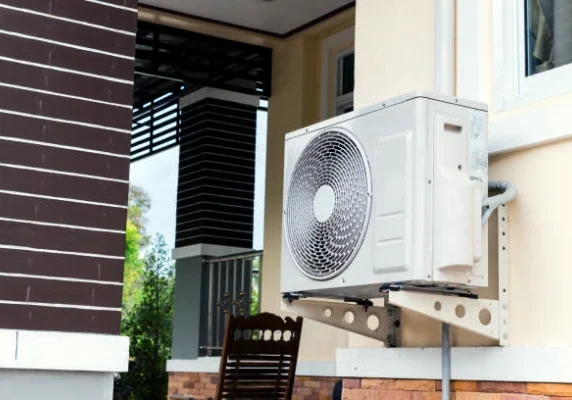Ductless Mini Splits vs. Central Air: Why Mini Splits Are More Efficient?

As homeowners seek maximum efficiency and personalized comfort, the debate over mini splits and central air systems becomes increasingly important. Mini-splits are the most efficient because they provide zoned cooling. This special feature lets you modify the temperature in each room separately, sparing energy that could have been wasted cooling empty spaces. Unlike a central air conditioner, which cools your whole house at once regardless of whether anyone’s home or not, mini splits only cool where it is important – truly a case of “why cool the whole backyard when all you need is a chilled lemonade?” Less energy spent equals lower utility bills and a happier, cooler you. Now, let’s discover the differences between mini splits and central air conditioners.
Mini Split vs Central Air Conditioner: Exploring Cooling Power
When it comes to cooling your home, achieving the right temperature in every room is crucial. With a mini-split system, you have the advantage of zoned cooling, which enables you to control the temperature of individual rooms or zones separately. This capability can be a game-changer for comfort and efficiency.
Imagine being able to set your bedroom to a cool 68°F for a good night’s rest while keeping the kitchen at a comfortable 75°F for a pleasant cooking experience. Zoned cooling with mini splits allows you to customize the temperature settings based on your unique needs in different areas of the house. No more wasting energy cooling unoccupied rooms or dealing with hot spots and cold drafts.
Mini Split Zoned Cooling Benefits:
- Personalized Comfort: Tailoring the temperature to each room’s specific function and occupants’ preferences.
- Energy Efficiency: By avoiding unnecessary cooling in unused areas, you can potentially reduce utility costs.
Conversely, central air systems work differently. They cool the entire house at once, which may result in energy waste as rooms that aren’t being used are still being cooled. It’s like having all your lights on when you only need one. This approach doesn’t give you precise control over each area’s comfort level and may lead to increased energy consumption and higher bills.
In summary, zoned cooling provided by mini split systems allows for personalized comfort and superior energy efficiency by delivering just the right amount of cooling to where it’s needed, while central air systems may lead to wasted energy in unoccupied areas.
Cost Analysis: Setup and Installation
Setting up a mini-split system usually comes with a higher initial cost than installing central air. That’s because mini splits require separate indoor units and the installation of refrigerant lines, which increases the upfront investment. However, it’s important to note that this can vary based on factors such as the size and type of the system, the number of units or zones required, and the labor needed for installation.
While mini-split systems may have a higher upfront cost, they can present savings in other areas. Homes without existing ductwork can experience lower installation costs since mini splits do not require ducts like central air systems do. This means there is no need for costly modifications to install ductwork in a home that doesn’t already have it.
For instance, if you opt for a high-quality mini-split system, you may notice substantial savings on your energy bills each month. Plus, the enhanced efficiency and energy savings provide a return on investment over time.
So, while the initial setup costs may cause some hesitation, it’s essential to weigh the long-term benefits when considering the overall cost-effectiveness of mini-split systems compared to central air.
Competing Systems: Operational Expenses
When considering ongoing operational expenses, central air systems may initially seem more convenient due to their comprehensive nature, but there’s an underlying story often overlooked: the cost of maintaining a central air system. Ductwork leaks and heat pickup contribute to higher operational expenses over time.
Firstly, let’s consider ductwork leaks. In traditional ducted systems, small leaks can add up to big problems. Leaky ducts can lead to significant energy losses as cooled or heated air escapes into spaces where it’s not needed. This means your system has to work harder and use more energy to keep your home at the desired temperature, resulting in higher energy bills.
Furthermore, heat pickup is another concern associated with central air systems. As the conditioned air travels through the ductwork, it picks up heat from the surrounding area—especially if the ducts are located in uninsulated or warm spaces like attics. This means the cooled air becomes warmer before it even reaches its destination, again forcing the system to work harder and consume more energy.
On the other hand, mini-splits are ductless, which eliminates the potential for such energy losses, resulting in lower operational costs and increased efficiency. By delivering air directly into each room or zone without relying on a network of ducts, mini-split systems effectively bypass the challenges of traditional ducted setups.
This means that mini-splits have a distinct advantage when it comes to operational efficiency, providing individualized control over each zone without losing energy along the way. Moreover, this direct delivery approach aligns well with modern energy-saving practices and is particularly beneficial in homes with varying usage patterns between different rooms or zones.
Although central air systems provide uniform cooling throughout a space, they come with inherent drawbacks that could lead to higher long-term operational expenses due to energy losses caused by ductwork leaks and heat pickup—challenges that are effectively mitigated by mini-split systems.

Room Temperature Control: Mini Splits vs Central Air
Imagine a scorching summer day. You’re trying to cool down inside your house, but as you move from room to room, you notice that some areas are colder than others. This happens because central air systems treat your entire house as one big space, cooling it all at once. Consequently, some rooms get too chilly, while others remain uncomfortably warm. It’s like trying to bake cookies and roast a chicken in the same oven—one of them is likely to be overcooked.
This is where ductless mini-splits stand out. Instead of treating your whole home as a single temperature zone, mini splits provide individualized cooling for each room through their multi-zone cooling feature. You can set different temperatures for different areas, ensuring that each space is comfortably cool without overcooling the entire house.
Precision Temperature Control
Mini-splits let you tailor the cooling to your specific needs and lifestyle. For example, if you spend more time in your living room during the day and your bedroom at night, you can adjust the temperature accordingly for each space. This targeted approach not only enhances comfort but also reduces energy waste by avoiding unnecessary cooling in unoccupied rooms.
You might think of it like adjusting the seat warmers in a car. If you drive solo most of the time, there’s no need to heat up the whole backseat—all you need is to make your own seat nice and cozy.
This personalized approach is particularly beneficial for homes with add-on spaces or converted rooms without ductwork, offering more flexibility in maintaining desired indoor temperatures without relying on a central air system that treats the entire house as one uniform environment.
By providing precise temperature control on a room-by-room basis, mini-splits offer a level of efficiency and comfort that centralized systems often struggle to achieve.
A Look at System Size: Mini Split Versus Central Air
The physical footprint of heating and cooling systems is a crucial factor to consider when making a choice. Here, mini split systems have a clear advantage in terms of size and flexibility. The indoor units of mini splits are compact, usually mounted on the wall, taking up minimal space compared to the larger indoor units typically found with central air systems.
This size difference makes mini split systems easier to install and maintain, as they require less space both indoors and outdoors, providing greater flexibility for homeowners who may have limited installation options. For example, if you live in a smaller home or apartment where space is limited, mini-splits offer an efficient and customizable solution without taking up valuable living space.
Moreover, because mini splits are designed to be smaller and more flexible, they impose less impact on the environment compared to central air systems. The reduced size means less material is needed for production, resulting in a lower environmental footprint throughout the lifecycle of the system.
Considering these physical and environmental factors in choosing a cooling system, it becomes apparent that mini splits offer a more streamlined and sustainable option compared to traditional central air systems.
Energy Efficiency: Why Mini Splits Excel
Let’s pull back the curtain on why ductless mini-splits are the superheroes of energy efficiency. One of the biggest advantages they offer is their use of variable-speed compressors. These smart machines can adjust their speed based on your cooling needs, unlike the all-or-nothing approach of traditional central air systems. This ability to modulate the temperature and power consumption ensures that energy isn’t wasted when you’re only looking for a slight chill.
Furthermore, standard central air systems cool an entire home at once, even if certain areas don’t need cooling at that moment. This is similar to turning on every light in your house when you’re only reading in one room—inefficient and wasteful. Ductless mini splits allow you to cool specific zones or rooms, minimizing unnecessary energy use where it’s not needed.
Final Words
By now, it’s clear that ductless mini-splits pack a powerful punch in terms of energy efficiency and environmental impact. Their ability to tailor cooling to specific zones and eliminate wasteful ductwork makes them an environmentally friendly choice that can lead to substantial energy savings and a reduced carbon footprint over time.
It’s truly fascinating how these small differences accumulate into major advantages for ductless mini splits. Their efficient use of electricity and tailored zoning make them an excellent choice for individuals who prioritize energy conservation and cost-effectiveness in their cooling solutions. For those seeking an environmentally friendly and cost-effective cooling solution, ductless mini splits stand out as efficient and practical options. If you’re considering making the switch, feel free to reach out to us for more information and guidance.
Have Any Questions?
Get in contact with us today! We are always happy to help, and you can count on our expertise.

